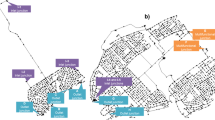Abstract
It is important and difficult to control the temperature of mass concrete structure during high arch dam construction. A new method with decision support system is presented for temperature control and crack prevention. It is a database system with functions of data storage, information inquiry, data analysis, early warning and resource sharing. Monitoring information during construction can be digitized via this system, and the intelligent analysis and dynamic control of concrete temperature can be conducted. This method has been applied in the construction of the Dagangshan Arch Dam in China and has proven to be very convenient. Based on the decision support of this system and the dynamic adjustment of construction measures, the concrete temperature of this project is well-controlled.
Similar content being viewed by others
References
Snozzi L, Caballero A, Molinari J F. Influence of the mesostructure in dynamic fracture simulation of concrete under tensile loading[J]. Cement and Concrete Research, 2011, 41(11): 1130–1142.
Camborde F, Mariotti C, Donze F V. Numerical study of rock and concrete behaviour by discrete element modeling[ J]. Computers and Geotechnics, 2000, 27(4): 225–247.
Belytschko T, Krongauz Y, Organ D et al. Meshless methods: An overview and recent developments[J]. Computer Methods in Applied Mechanics and Engineering, 1996, 139(1–4): 3–47.
Song J H, Wang H, Belytschko T. A comparative study on finite element methods for dynamic fracture[J]. Computational Mechanics, 2008, 42(2): 239–250.
Liu X Y, Xiao Q Z, Karihaloo B L. XFEM for direct evaluation of mixed mode SIFs in homogeneous and bimaterials[J]. International Journal for Numerical Methods in Engineering, 2004, 59(8): 1103–1118.
Chen S H, Su P F, Shahrour I. Composite element algorithm for the thermal analysis of mass concrete: Simulation of lift joint[J]. Finite Elements in Analysis and Design, 2011, 47(5): 536–542.
Kim J K, Kim H K, Yang J K. Thermal analysis of hydration heat in concrete structures with pipe-cooling system[J]. Computers and Structures, 2001, 79(2): 163–171.
Myers T G, Fowkes N D, Ballim Y. Modeling the cooling of concrete by piped water[J]. Journal of Engineering Mechanics, 2009, 135(12): 1375–1383.
Zhu Bofang. Pipe cooling of concrete dam from earlier age with smaller temperature difference and longer time[J]. Water Resources and Hydropower Engineering, 2009, 40(1): 44–50 (in Chinese).
Fu Shaojun, Zhang Shihu, Xie Min et al. Dynamic analysis theory and practice for temperature control and cracking prevention of concrete arch dam[J]. Chinese Journal of Rock Mechanics and Engineering, 2012, 31(1): 113–121 (in Chinese).
Dai Huichao, Cao Guangjing, Su Huaizhi. Management and construction of the three gorges project[J]. Journal of Construction Engineering and Management, 2006, 132(6): 615–619.
Zhong Denghua, Li Jingru, Zhu Huirong et al. Geographic information system-based visual simulation methodology and its application in concrete dam construction processes[J]. Journal of Construction Engineering and Management, 2004, 130(5): 742–750.
Yang Sheng-Yuan, Chang Yi-Yen. An active and intelligent network management system with ontology-based and multi-agent techniques[J]. Expert Systems with Applications, 2011, 38(8): 10320–10342.
Author information
Authors and Affiliations
Corresponding author
Additional information
Supported by the National Natural Science Foundation of China (No. 50909078) and the National Basic Research Program of China (“973” Program, No. 2013CB035900).
Jing Xiangyang, born in 1987, male, doctorate student.
Rights and permissions
About this article
Cite this article
Jing, X., Liu, X., Zhou, W. et al. Real-time temperature control for high arch dam based on decision support system. Trans. Tianjin Univ. 20, 118–125 (2014). https://doi.org/10.1007/s12209-014-2210-1
Accepted:
Published:
Issue Date:
DOI: https://doi.org/10.1007/s12209-014-2210-1




